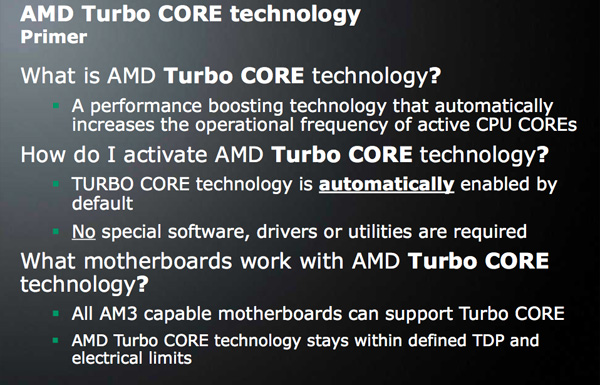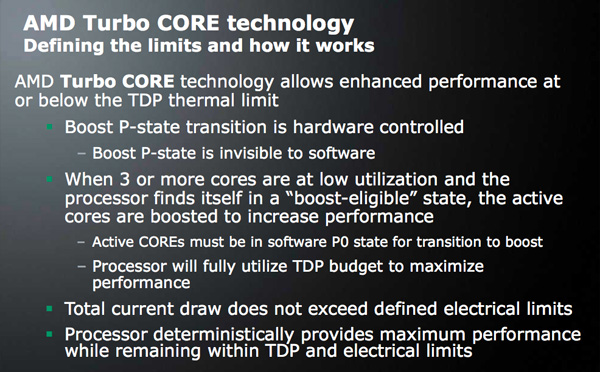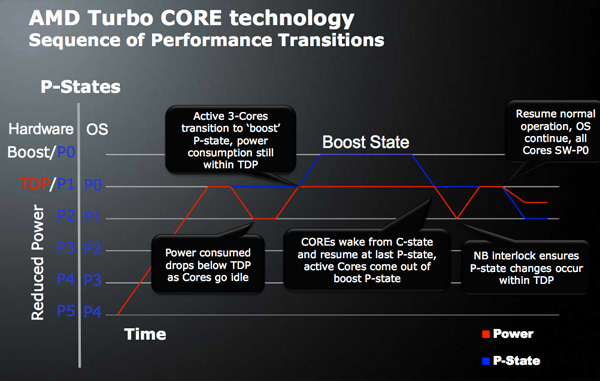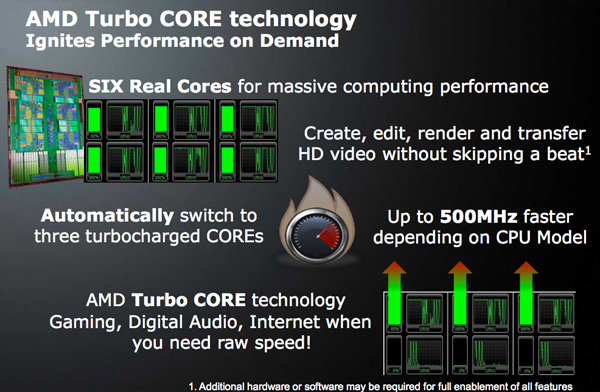AMD Divulges Phenom II X6 Secrets, Turbo Core Enabled
by Anand Lal Shimpi on April 8, 2010 12:00 AM ESTLast month Intel introduced its first desktop 6-core CPU, the 32nm Gulftown Core i7 980X. Running at 3.33GHz we loved the fact that it’s quite possibly the first Extreme Edition part that is able to justify its price. For $999 you get six cores and better performance all in the same power envelope as the current high end quad-core i7s.
The 980X is a great chip, but spending $999 on a single component in your PC is a tough sell for most folks. Luckily, AMD is coming out with its own 6-core processors codenamed Thuban. Below is what we know so far about AMD's Thuban lineup (note, the information in the table was not provided by AMD):
| AMD 2010 Roadmap | |||||||
| CPU | Clock Speed | Max Turbo (<= 3 cores) | L3 Cache | TDP | Release | ||
| AMD Phenom II X6 1090T | 3.2GHz | 3.6GHz | 6MB | 125W | Q2 | ||
| AMD Phenom II X6 1075T | 3.0GHz | 3.5GHz | 6MB | 125W | Q3 | ||
| AMD Phenom II X6 1055T | 2.8GHz | 3.3GHz | 6MB | 125W/95W | Q2 | ||
| AMD Phenom II X6 1035T | 2.6GHz | 3.1GHz | 6MB | 95W | Q2 | ||
| AMD Phenom II X4 960T | 3.0GHz | 3.4GHz | 6MB | 95W | Q2 | ||
Officially branded the Phenom II X6, AMD won’t be launching these processors until some time in the future. But today AMD is disclosing some basic details about the parts. We’re also mixing in our knowledge of internal AMD roadmaps to paint a clear picture of AMD’s 6-core strategy.
The more cores at the same TDP feature that Intel delivers with the 980X, AMD is also promising with Phenom II X6. The difference is that these are still 45nm parts. While we’ll have to test them to be sure, AMD currently indicates that the entire Phenom II X6 lineup will be rated at 95W or 125W TDPs. It’s all manufacturing tricks that make it possible (good job GlobalFoundries). In theory you should be able to buy a Phenom II X6 and have it operate in the same power envelope as a Phenom II X4 965.

With the Thuban cores AMD is introducing its version of Intel’s Turbo Boost technology called Turbo Core. AMD has yet to implement power gating on its processors, so Turbo Core works a little differently than Intel’s Turbo.
Turbo Core kicks in when 3 or more cores (on a 6-core part) are idle. When this happens, the frequency of those three cores is reduced to 800MHz, the voltage to the entire chip is increased, and the remaining three cores are turboed up by as much as 500MHz. It doesn’t get any more granular than this. If you have 3 or more cores idle, then the remaining turbo up. In any other situation the CPU runs at its normal clocks.

The CPU handles all monitoring and does the clock/voltage management itself. The switch to turbo up cores apparently happens fast enough to deal with Windows moving threads around from core to core.

Turbo core is triggered by a deterministic system that is based on load demand and current operating conditions (not temperature).
Cool’n’Quiet is active throughout the turbo process. What actually happens is that when CnQ looks to see if a set of cores should be downclocked, it also has the ability to increase the frequency of other cores.

This isn’t nearly as elegant of a solution as Intel’s turbo. The idle cores are never actually shut off, and voltage to all cores is increased to reach the higher clock speed. However if it works as advertised with no drawbacks (e.g. underclocking 3 cores when you actually still need them) then it’s definitely better than nothing for the Phenom II lineup. AMD will also have quad-core CPUs with turbo core support based on the new Thuban cores.
The great news? All Socket-AM3 and AM2+ motherboards will work with these new Phenom II X6 CPUs with nothing more than a BIOS update. The boards do have to support the TDPs the chips are rated for of course.
Pricing and performance are both unknowns at this point. We’ll keep you posted!










58 Comments
View All Comments
jretter07 - Sunday, April 11, 2010 - link
The leakage of an idle core is 2-3W at nominal voltage. In Turbo mode, voltage is increased for all cores, so the leakage of the three clock gated cores could reach 5W each. That's just wasted power. I would rather go for Intel's solution, where idle cores don't run up my electricity bill.-J
qwertymac93 - Monday, April 12, 2010 - link
IIRC amd cpus have the ability to lower voltages to cores individually. while the whole cpu would see a slight voltage increase, the idle cores would still have lowered voltages(.85v?)stardude82 - Sunday, April 11, 2010 - link
The K10 is way behind Nahelem on a per clock basis (and behind Core also). If you look at the 975 and 980x benchmarks, the only thing that the extra core helps with is encoding. So after a year and a half, AMD finally has an answer to the 920.TheFlyingSquirrel - Sunday, April 11, 2010 - link
AMD's great support for each socket is what keeps me with them at the momentperformance great for the price and a plethora of CPU's
can always count on AMD for a great value
apriant - Thursday, April 15, 2010 - link
i buy phenom II x4 965 few days ago,n these 6's will came out soon..damn..but thx to amd with their supported socket am3/am2..thats how i loved amd :D
phenom_x8 - Saturday, April 17, 2010 - link
WHy there is still no review about this new processor?? Anand, have you ever check that in my country, its have been around for quite some time(12th of April), especially the 1055T and 1035 T .A lot of people also sell it on many forum only for $218 . This is the link http://www.kaskus.us/showthread.php?t=3876654 (Sorry, its in Indonesian)
REVIEW PLEASE, IMPORT IT IF YOU HAVE TO (Dont wait for any sample from AMD)
warmon6 - Friday, April 23, 2010 - link
im guessing they already have the cpu and benched-mark it, although the reason why they posted nothing is because AMD has tech web sites like Anandtech, toms hardware, ect are on a NDA with them.So even if they have the stuff ready to post, that NDA prevent them posting the info up. Breaking the NDA is something they wont do as it will create many problems like not receiving samples of cpu's.
Wolfpup - Friday, April 23, 2010 - link
Wow, wasn't expecting to see 6-core CPUs from AMD so fast. These could actually be fairly interesting and competative. I mean probably Intel will just introduce cheaper 6-core CPUs, but right now at least a 6 core one with six less powerful cores might still be intersting versus a 4-core with more powerful cores.At any rate, it's great to see.